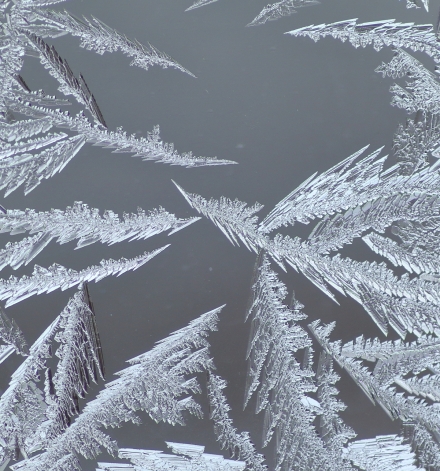Frost can be beautiful. One of the benefits of poorly insulated windows, at least for small children, is the beautiful lace shapes that form – so delicate and yet so enchanting.
Despite this beauty, there are plenty of places where in a home you do NOT want to see frost forming. Certainly, when found on windows, it is a clear sign that the window is not very good at insulating. Another place where you don’t want to see frost, is inside your attic.
Appearance
Frost in the attic can appear as white condensation on the underside of the roof decking, but most commonly, it will be found growing on the tips of the roofing nails that protrude through the sheathing.
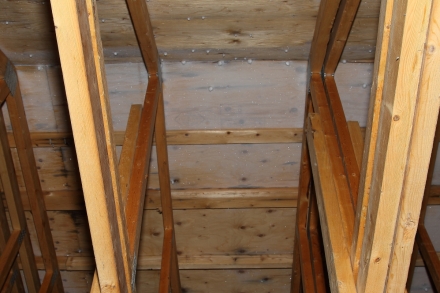
Frost on underside of roof decking. Note the growth of frost on the nails.
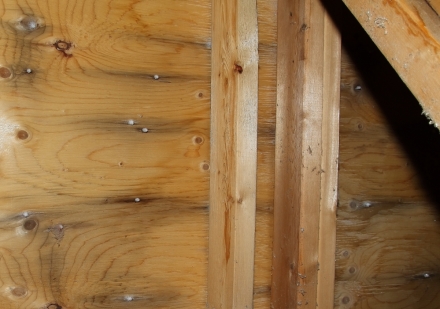
Note the frost forming at the tips of the nails.

One way you can see if there were condensation icicles is to see these drip marks on attic materials. This inspection was done when the attic was above freezing temperature.
What does this mean?
Condensation in the attic, especially in sufficient quantity for form icicles on roofing nails, or covering the underside of decking, means at least the following:
- There is a source of moisture that is bringing moisture into the attic faster than can be dissipated by ventilation.
- The venting is inadequate to keep the attic dry.
In the above image, the source of moisture is a persistent ice dam that forced the water into the decking.
In other situations, the moisture can be coming from poor air sealing, which allows relatively moist interior air to enter the attic space and condense. The image below is of the damage caused by such condensation as seen from the inside.
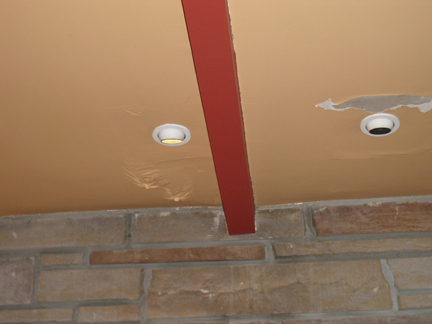
Pot lights, unsealed and uninsulated, that allowed interior (moist) air to enter the attic and condense.
Sometimes the moisture is entering the attic through poor duct sealing, incorrect venting of plumbing vents into the attic, or poor handling of outlet ducts from bathrooms, kitchens, driers, and the like. Below is an image of one such poorly installed vent.
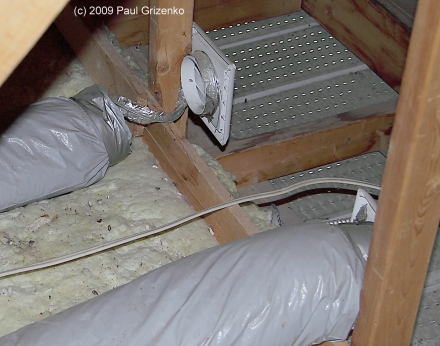
Bathroom vent improperly connected to vent INSIDE the attic. Notice the condensation and water stains on the wood surrounding the vent.
Possible consequences
Frost in the attic is signalling that there is too much humidity in the attic, and this humidity has some (or all) of the following consequences:
- Mold growth
- Delamination of plywood
- Deterioration of glue holding OSB together.
- Reduction of insulation value due to wet insulation, with consequent cold spots, and increased heat consumption.
- Increased potential for ice dam formation.
- Support of conditions favourable to carpenter ants.
- Rotting of decking, structural members, joists
- Interior damage to the gyproc, or plaster, or inside wood finish.
How to fix
There are two actions to fix the immediate problem:
- Find the source(s) of moisture and stop it. This can sometimes require extensive detective work if the sources are not obvious.
- Improve the ventilation throughput to ensure the attic is dry. This requires a proper assessment of ventilation to be conducted.
There are additional actions that are needed if the problem was long-lasting. They include:
- Fix the damaged wood decking and/or supporting joists,
- Remove the mold, mildew and fungus and decontaminate the area
- Remove and replace the moisture-damaged insulation
- If poor air sealing was part of the problem, conduct proper air-sealing to ensure no more interior air can enter the cold spaces
- Call a pest control expert to kill the carpenter ants.
- Repair the interior damage, including replacing the vapour and air barriers.
When to do this?
The best time to investigate condensation in attics is during the winter, when the outside tempertures are significantly below freezing (say -8C or lower), and have been below freezing for at least a few days. This will then allow the moisture to accumulate and makes it easier to identify. For the Montreal area, this means that the best times to conduct this type of inspection is during January, February and the early half of March.
To arrange an inspection, call us at 1-514-636-2300, or email us at prsroofinginc@gmail.com.
(c) 2017 Paul Grizenko

